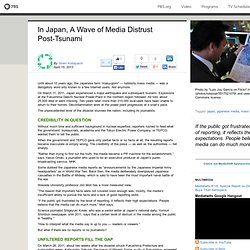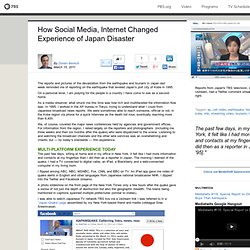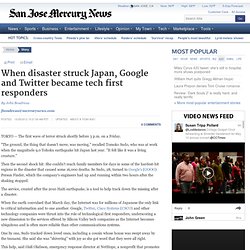

SOS from Mayor of Minami Soma City, next to the crippled Fukushima nuclear power plant, Japan. Person Finder. Visualization: @replies (Archive) Tsunami in Otsuchi, Iwate Prefecture. Dramatic New Video of Japan Tsunami. Why do people post these? Japan Geigermap: At-a-glance. GeoSense. In Japan, A Wave of Media Distrust Post-Tsunami. Until about 10 years ago, the Japanese term “masu-gomi” — rubbishy mass media — was a derogatory word only known to a few Internet users.

Not anymore. On March 11, 2011, Japan experienced a major earthquake and subsequent tsunami. Explosions at the Fukushima Daiichi Nuclear Power Plant in the northern region followed. All told, about 25,000 died or went missing. Two years later, more than 310,000 evacuees have been unable to return to their homes. The unprecedented level of the disaster stunned the nation, including its journalists. Credibility in Question Without much time and sufficient background in nuclear expertise, reporters rushed to feed what the government, bureaucrats, academia and the Tokyo Electric Power Company, or TEPCO, wanted them to tell the public.
When the government and TEPCO gave only partial facts or no facts at all, the resulting reports became inaccurate or simply wrong. Waseda University professor Jiro Mori has a more measured view. Unfiltered Reports Fill the Gap. How Social Media, Internet Changed Experience of Japan Disaster. The reports and pictures of the devastation from the earthquake and tsunami in Japan last week reminded me of reporting on the earthquake that leveled Japan’s port city of Kobe in 1995.

On a personal level, I am praying for the people in a country I have come to see as a second home. As a media observer, what struck me this time was how rich and multifaceted the information flow was. In 1995, I worked in the AP bureau in Tokyo, trying to understand what I could from Japanese broadcast news reports. We were sometimes able to reach someone, official or not, in the Kobe region via phone for a quick interview as the death toll rose, eventually reaching more than 6,400. We, of course, covered the major news conferences held by agencies and government offices.
Multi-platform Experience Today The past few days, sitting at home and in my office in New York, it felt like I had more information and contacts at my fingertips than I did then as a reporter in Japan. Huge Amounts of Video Related. When disaster struck Japan, Google and Twitter became tech first responders. TOKYO -- The first wave of terror struck shortly before 3 p.m. on a Friday.

"The ground, the thing that doesn't move, was moving," recalled Tomoko Sudo, who was at work when the magnitude 9.0 Tohoku earthquake hit Japan last year. "It felt like it was a living creature. " Then the second shock hit: She couldn't reach family members for days in some of the hardest-hit regions in the disaster that caused some 16,000 deaths. So Sudo, 28, turned to Google's (GOOG) Person Finder, which the company's engineers had up and running within two hours after the shaking stopped. The service, created after the 2010 Haiti earthquake, is a tool to help track down the missing after a disaster. When the earth convulsed that March day, the Internet was for millions of Japanese the only link to critical information and to one another. One by one, Sudo tracked down loved ones, including a cousin whose house was swept away by the tsunami.
U.S.